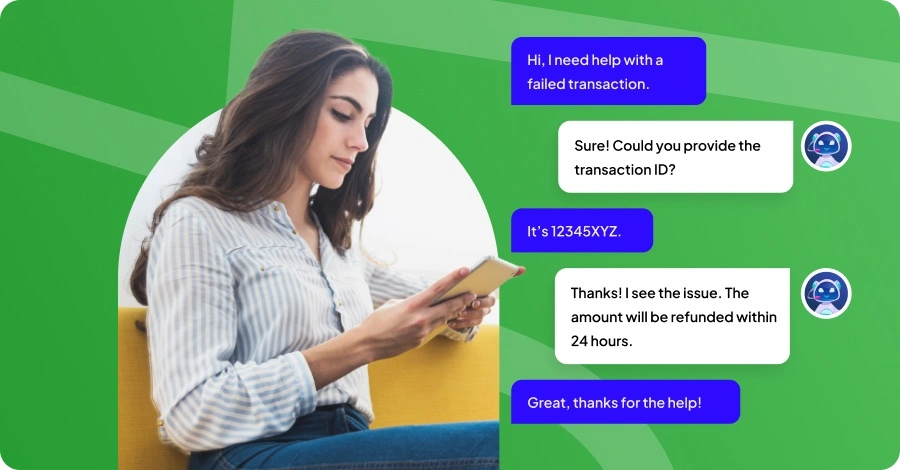Sorry for the Inconvenience: Caused, Alternatives & Email Templates
- March 16, 2022
- 28 mins read
- Listen
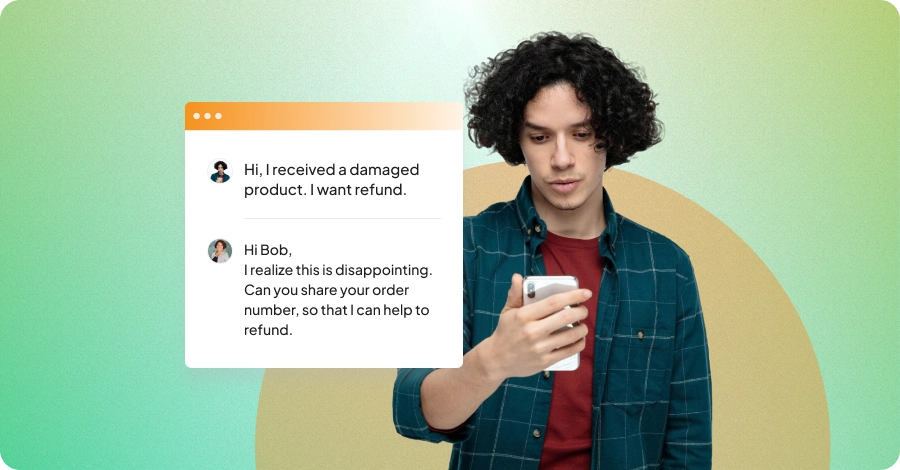
Table of Content
Have you ever been frustrated by a service disruption or delay and received nothing more than a generic “Sorry for the inconvenience”? While this phrase is commonly used, it often fails to address the root of the problem or offer a meaningful resolution. In this blog, we’ll explore more effective alternatives to “Sorry for the inconvenience” that can enhance customer communication and improve their overall experience.
What you’ll get to know in this comprehensive sorry for the inconvenience alternative blog? We have covered everything from personalized apology techniques to better ways of handling complaints. We’ll provide actionable insights to help you strengthen customer relationships through thoughtful, sincere responses.
Sorry for the Inconvenience Meaning
Sorry for the inconvenience is a phrase used to express regret when someone experiences discomfort, disruption, or frustration due to an issue caused by another person or organization. It’s a way to acknowledge that the situation has affected someone negatively and to convey empathy for the trouble it has caused.
It’s polite to say, “Hey, I realize this wasn’t ideal, and I genuinely regret any trouble it may have caused you.” So, it’s like a little apology wrapped up in understanding that things didn’t go smoothly.
Undoubtedly, a sincere apology goes beyond just saying “sorry.” It includes acknowledging the mistake or issue, taking responsibility, and expressing genuine regret. It offers a solution or way to make amends. Besides, it includes a commitment to prevent the issue from happening again. This means it reassures the recipient that their concerns are taken seriously.
Here is an example;
Sorry for the Inconvenience Synonyms
If you are looking for some amazing sorry for the inconvenience synonyms to boost your customer service level then below are some alternatives. I hope these decent alternatives will help you a lot to apologize when any inconvenience caused.
- I Realize This Is Disappointing
- I Understand Your Frustration
- Please Accept My Sincere Apology
- Please Let Me Know If There Is Anything I Can Do
- I Apologize Unreservedly
- Thanks for Your Patience
- Let Me Help
- I Apologize for Any Inconvenience This May Cause and Appreciate Your Understanding
- We Sincerely Apologize for the Inconvenience Caused
- We Apologize for the Disruption
- We Regret Any Trouble This May Have Caused
- Thank You for Bringing This to Our Attention
- We Appreciate Your Understanding
- We’re Working to Resolve This Issue as Quickly as Possible
- I Regret Any Confusion This May Have Caused
Types of Inconveniences
You cannot deny the fact the importance of understanding the types of inconveniences customers may face. Let’s see the types of inconveniences that your customers might have.
- When a product or service is delivered later than expected, and disrupts the customer’s plans.
- When a customer experiences glitches, crashes, or bugs while using a product or service.
- Incorrect charges or discrepancies in a bill that require the customer to seek clarification or correction.
- When a customer attempts to purchase an item that is unexpectedly out of stock.
- When a customer experiences delayed or unclear communication from the company.
- When a service is temporarily unavailable due to maintenance or unexpected outages.
- When a customer receives the wrong product, or their package is lost in transit.
- When incorrect or unclear information leads to a misunderstanding or confusion.
- When scheduled appointments or services are delayed or rescheduled.
- When customers encounter broken links, inaccessible pages, or errors while navigating a website.
- When a customer receives a product that is damaged or not functioning as expected.
- When an ongoing service is interrupted or unavailable for some time.
- When a customer is surprised by hidden fees or additional costs that were not communicated.
- When a customer experiences extended hold times when trying to reach customer support.
- When a promotion or offer ends sooner than expected, and the customer misses out.
When to Say “Sorry for the Inconvenience” to Your Customers?
Sorry for the inconvenience is often used to address a wide range of situations. Where a customer’s experience has been negatively impacted. This phrase helps acknowledge the inconvenience. While expressing empathy and a willingness to make things right.
The following are common scenarios where using the phrase “Sorry for the inconvenience” is appropriate and necessary:
- Customer Orders Will Arrive Later Than Anticipated
We sincerely apologize for the delay in your order’s arrival. We understand your frustration and are working to resolve this issue as quickly as possible. I appreciate your patience.
- Temporary Service Outage That Affects Their Access
We apologize for the disruption caused by the temporary service outage. We appreciate your understanding as we work to restore access as soon as possible.
- Overcharge or Incorrect Billing Issue With a Customer
We regret any trouble this billing issue may have caused. Please accept my sincere apology for the overcharge. Let us know if there’s anything we can do to rectify this.
- Customers Experiencing Issues With a Mobile App or Software
I understand your frustration with the issues you’re experiencing with our app. We apologize unreservedly and are working diligently to fix the problem. Thank you for bringing this to our attention.
- The Appointment Needs to Be Rescheduled Due to Unforeseen Circumstances
We apologize for any inconvenience this rescheduling may cause. We appreciate your understanding and will ensure to accommodate you at your earliest convenience. Please let me know if there is anything else we can assist with.
- Customer Complaints About a Defective or Damaged Product
We sincerely apologize for the defective product you received. We regret any trouble this may have caused and are here to help resolve the issue. Thank you for your patience and understanding.
- Misinformation That Led to Customer Confusion or Frustration
I regret any confusion this misinformation may have caused. We apologize for any inconvenience and are committed to providing accurate information moving forward. Please accept my sincere apology.
Customer Perception of Inconveniences
Minor issues, such as a brief delay in response time, might be forgiven easily if handled promptly. However, more significant problems like repeated technical issues or major billing errors can lead to frustration and dissatisfaction. If not addressed with care.
The key to managing customer perception is empathy and swift resolution. When a customer feels heard and knows that their issue is being taken seriously. There is no doubt that they are more likely to remain loyal despite the inconvenience. This is why the phrase “sorry for the inconvenience” is often paired with a commitment to resolve the issue as quickly as possible. It shows customers that their experience matters.
15 Powerful Sorry for the Inconvenience Alternatives
Customer service can be hard, but we think it doesn’t have to be. That’s why we’re happy to introduce the best 15 sorry for the inconvenience and alternatives to deliver better customer service.
1. I Realize This Is Disappointing

You should recognize the customer’s disappointment faster and take ownership of the mistake. In this case, you’ll have to put yourself in the customer’s shoes and make them realize that you are thinking of their perspective. Be a good listener and focus on customer sentiment. If a customer goes through disappointment just say I realize this is disappointing, but I am here to help you the best way possible.
Template:
According to a recent report, 75% of customers are unsatisfied with the customer service they receive.
“I realize this is disappointing” is a much better alternative to “Sorry for the inconvenience”.
Pro Tips:
- Make sure your customer acknowledges that you are aware of your faults and aim to fix things. It will grow confidence and build trust in the relationship.
- Making customers feel heard is important. There is no doubt that we all feel that we are special. No matter whether your customer complaints are common or not, you should take some time to make your customers feel heard.
2. I Understand Your Frustration

It is needless to say sometimes your products or services are not suitable for every customer. However, it is very common and there is nothing wrong with it.
If a customer is frustrated with the product or any service and asks for a refund it doesn’t mean that you should treat the customer differently. Communicate with the customer with respect. Who knows you are going to regain the customer down the line.
Template:
If you are a customer service representative, don’t dismiss the customer complaint just by saying ‘’sorry for the inconvenience’’.
You should go through what customers are feeling and accept the blame. It will help to retain more customers and create a loyal customer base.
Pro Tips:
- When you say I understand your frustration then the customer will acknowledge that you are also feeling empathy for the situation.
3. Please Accept My Sincere Apology

“Please accept my sincere apology” is a phrase that a customer service agent can use to ask for an apology when a customer experiences delays getting any service or products from your company or brand. However, to do it, they have to understand how to embrace the right tone.
Template:
Pro Tips:
- It’s important for the customer service team to always be responsive and to acknowledge mistakes quickly. If a company is not taking an active role in acknowledging problems, people will not trust the company any longer.
- Frustrated customers can be extreme or aggressive. Make sure you are giving some time yourself to understand how are you feeling, too.
4. Please Let Me Know If There Is Anything I Can Do

It is another great alternative you can use instead of sorry for the inconvenience.
When you are communicating with a customer to provide assistance. You can say simply ‘’Please let me know if there is anything I can do to help resolve the problem’’. This phrase shows your willingness to support the customer.
Template:
Pro Tips:
- There is a lot of competition out there, and people are happy to pick a product with better customer service. Worse yet, unhappy customers can easily rant and rave online. So, it can result in bad reviews and social media, dragging you down further. Make sure you are assisting your customer always.
5. I Apologize Unreservedly

The most important thing is to make sure your customers feel like they have been heard.
Additionally, it is good to know that saying this phrase will resolve the situation faster than a regular apology because it comes from a place of sincerity.
Template:
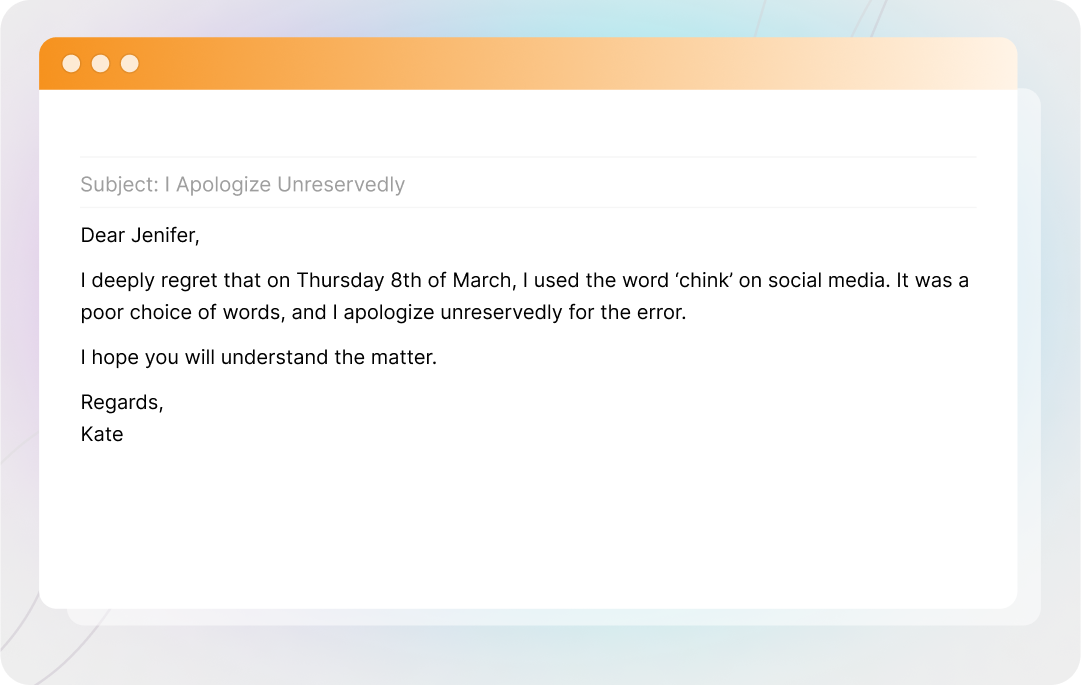
You just can’t make the customer happy just by saying sorry for the inconvenience to address all uncaring and flippant.
However, if you have made an error of judgment which resulted in someone’s serious offense or inconvenience then you can say ‘’I apologize unreservedly’’.
6. Thank You for Your Patience

On the surface, customer service is often a light-hearted affair, but underneath that, it’s a serious business. A little can make or break the relationship with the customers. Treating the customer with respect and value is crucial for any business. So, thank you for your patience can be a great alternative to dealing with customers.
Template:
In fact, in many ways, it’s one of the most difficult tasks you could undertake. That’s because customer service is like an iceberg; nine-tenths of it is underwater, and you can’t see it unless you’re in the business or sitting in a chair.
Pro Tips:
- There is no doubt that some people don’t like the apology they need to solve the issues that caused inconvenience. In these cases, you can say something that is not trite, however, also free from an unnecessary apology.
7. Let Me Help

People ask for help when they are disappointed. Instead of showing an apology, offer them help. This is what they are looking for from you.
Let me help – is a phrase that literally means – let me assist you. It sounds very polite.
It’s worth mentioning, that it does not matter what kind of work you do, or what kind of company you work for, saying the phrase ”let me help” can always be useful. Instead of saying sorry for the inconvenience you can use let me help you.
Template:
The first and most important reason for using this phrase is to make an impression on your audience or customer. You can make them feel that you are a sincere and attentive person.
By saying ”let me help”, you show that you are willing to assist your customer.
Pro Tips:
- Have you ever spent hours on the way to solve a problem and found the solution? You will never forget what you went through when you looked for that answer. Make sure your customers can find answers quickly and easily.
- Customers sometimes have difficulties when shopping online. Some do not know how to find answers to their problems, and some do not know how to ask for help.
8. I Apologize for Any Inconvenience This May Cause and Appreciate Your Understanding

The phrase “I apologize for any inconvenience this may cause and appreciate your understanding” is commonly used in situations where a person or organization needs to inform someone about a potential inconvenience or disruption to their plans. They want to express their regret while seeking the recipient’s understanding.
It is often used in emails, letters, or other forms of communication to acknowledge the inconvenience and show appreciation for the recipient’s patience and understanding. This phrase is ideal for saying thank you for your patience.
Template:
9. We Sincerely Apologize for the Inconvenience Caused

The phrase “We sincerely apologize for the inconvenience caused” is mostly used when a person or organization wants to express genuine regret for an inconvenience that has been caused to someone. It is typically used in situations where there has been an error, mistake, delay, or any other unforeseen circumstance that has resulted in inconvenience for the recipient.
This phrase is often used in emails, letters, or other forms of communication to acknowledge the inconvenience and offer an apology.
Template:
10. We Apologize for the Disruption
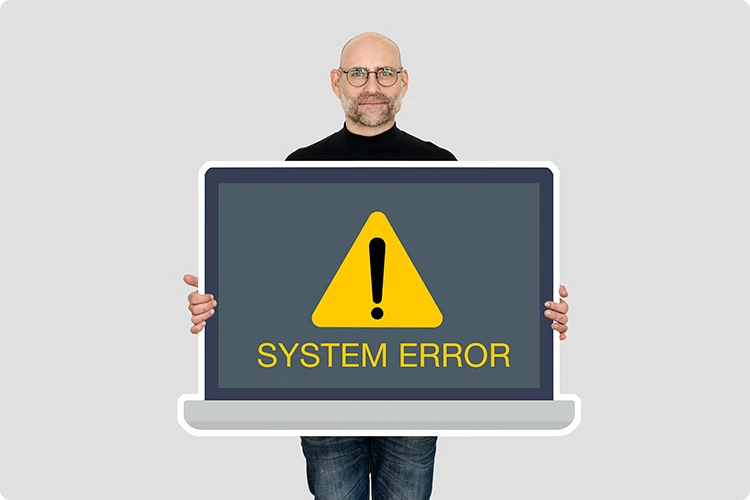
You’re cruising along, minding your own business, and then bam! Something unexpected happens, throwing a wrench in your plans. It could be a website crash, a sudden service outage, or a glitch in the system. You’re left scratching your head, wondering what went wrong.
Now, imagine receiving an email from the company responsible for the hiccup. It starts with a simple yet powerful line: “We apologize for the disruption.” It’s like a virtual hand reaching out, acknowledging the chaos, and saying, “Hey, we see what happened, and we’re sorry for the hassle it caused you.”
This phrase acknowledges the disruption caused by the inconvenience while expressing a sincere apology. It conveys empathy and recognizes the impact on the affected party’s experience.
Template:
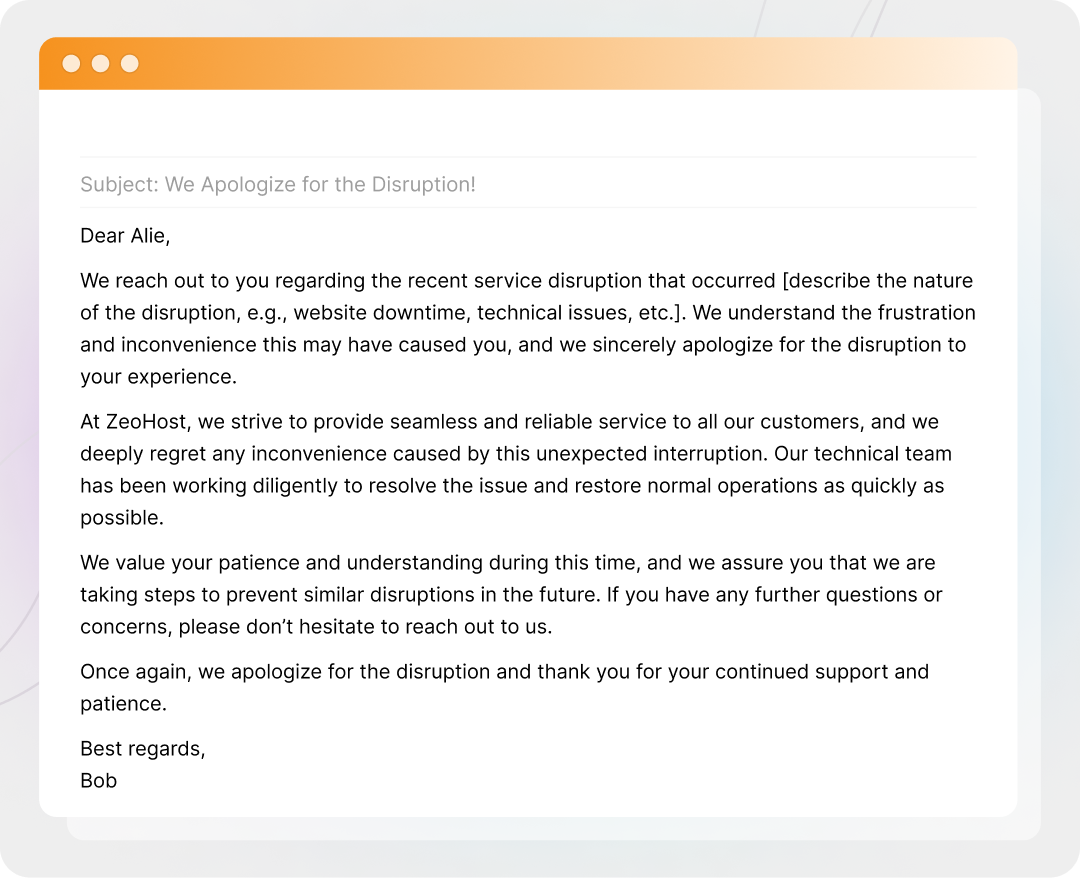
Pro Tips:
- When using this phrase, it’s important to acknowledge the specific impact of the disruption on the affected party. Whether it’s a website crash, a service outage, or a logistical delay. You must recognize the inconvenience to help validate the customer’s experience.
11. We Regret Any Trouble This May Have Caused

The phrase “We Regret Any Trouble This May Have Caused” is best used when acknowledging an issue that has impacted multiple customers or caused a significant disruption. It’s appropriate for situations where your actions (or a system failure) have inconvenienced others, and you want to express remorse in a more formal and considerate tone.
Template:
Pro Tips:
- Show genuine empathy for the inconvenience or trouble experienced by the affected party. Acknowledge the frustration or inconvenience they may have encountered and convey an understanding of their perspective. A heartfelt expression of empathy helps validate the customer’s feelings and fosters a sense of connection.
12. Thank You for Bringing This to Our Attention

The phrase “Thank You for Bringing This to Our Attention” is typically used in situations where a customer or client has identified an issue, error, or area of improvement that the company may not have been aware of. This phrase is employed to acknowledge the customer’s effort in reporting the problem and express gratitude for their proactive communication. Most importantly, it shows a commitment to addressing the concern.
This phrase is often used in customer service emails, letters, or other forms of communication to recognize the importance of the feedback. It reassures the recipient that their input is valued. This phrase is ideal for expressing appreciation and building a positive relationship with the customer.
Template
Pro Tips:
- Promptly acknowledging the customer’s issue shows that you value their feedback and are committed to resolving the problem.
- If possible, offer an immediate solution or outline the steps being taken to fix the issue.
- Always thank the customer for their feedback.
13. We Appreciate Your Understanding

You can use the phrase “We appreciate your understanding” instead of “Sorry for the inconvenience”. This amazing phrase is suitable to use when a company is experiencing unexpected shipping delays due to a sudden increase in order volume during a holiday sale.
As a result, customers who place orders are facing longer delivery times than initially promised. In this case, if you want to address the issues promptly, you need to inform the affected customers about the delay and express appreciation for their patience.
Template
Pro Tips:
- You should clearly explain the reason for the delay or issue. It helps build trust and shows the customer that the situation is being managed with care.
- Whenever possible, provide an updated estimate or timeline to manage the customer’s expectations and reassure them that the issue is being resolved.
14. We’re Working to Resolve This Issue as Quickly as Possible

If you want to use this phrase in a perfect situation you can put yourself in a situation. For example, a software company releases a new update for its application, but shortly after the release, users begin reporting a bug that causes the app to crash unexpectedly.
This bug is affecting many users, disrupting their ability to use the application effectively. The company’s technical support team needs to communicate with affected users, acknowledge the issue, and reassure them that the team is actively working on a solution. In this case, the technical support team can use the “We’re Working to Resolve This Issue as Quickly as Possible” phrase.
Template
Pro Tips:
- Promptly recognizing the problem shows customers that you are aware of their concerns and that you’re taking them seriously.
- Using phrases like “as quickly as possible” conveys a sense of urgency and commitment to resolving the issue, which helps maintain customer confidence.
15. I Regret Any Confusion This May Have Caused

When to use the “I Regret Any Confusion This May Have Caused”? If you want to use this phrase in a customer service setting then you can imagine a situation like this. For example, a business recently sent out an email to customers announcing a new promotion. However, there was a mistake in the terms and conditions.
The email stated that the discount was available for all products. However, the promotion only applied to select items. In this case, several customers attempted to apply the discount to products. But they’re not covered by the promotion, so they reached out to customer service for clarification.
The company needs to send a follow-up email to clarify the terms and apologize for the confusion caused by the mistake.
Template:
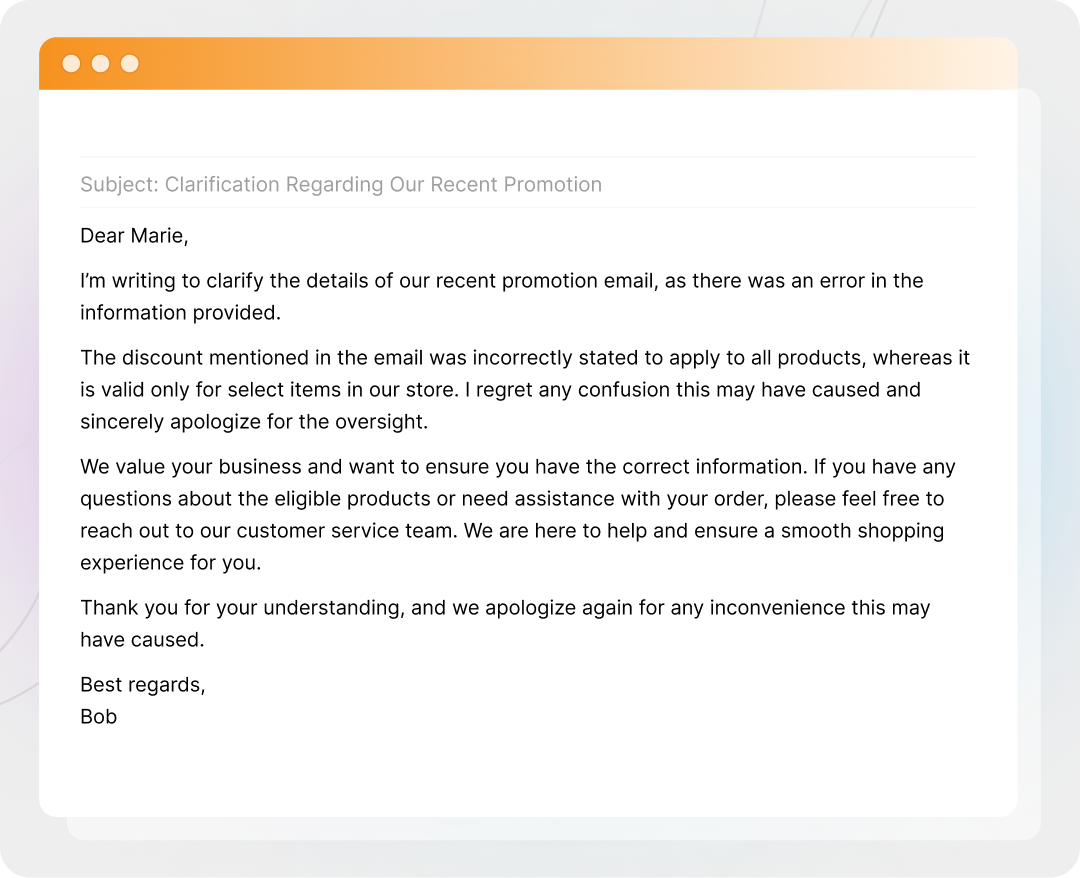
Pro Tips:
- Be upfront about the mistake to prevent further confusion. This transparency shows customers that you’re taking responsibility.
- After acknowledging the error, you must immediately offer the correct details to clear up any misunderstandings and help the customer move forward.
Effective Tips for Improving Customer Service Interaction
Undoubtedly, creating a well-thought-out apology email is crucial. It can turn a negative experience into an opportunity to demonstrate your company’s commitment to customer satisfaction.
Besides, when your customers get a better experience, your customer retention rate will be higher.
Here is how you can do that.
1. Apology Email Template to Address Customer Complaints
When a customer experiences an issue, a carefully crafted apology email can help mend the situation and reinforce trust. Below is a standard email template you can use to address customer complaints:
Subject: Our Apologies for [Specific Issue]
Dear [Customer’s Name],
I would like to apologize for the inconvenience you’ve experienced regarding [specific issue]. We understand how frustrating this must be, and we are truly sorry for any disruption this may have caused.
Please know that our team is working diligently to resolve this matter as quickly as possible. In the meantime, if there’s anything further we can do to assist you, please don’t hesitate to let us know.
We greatly appreciate your patience and understanding as we work through this. Thank you for your continued trust in [Company Name].
Best regards,
[Your Name]
2. How to Write Templates Yourself?
When you’re creating personalized templates, you have to be more cautious. An effective apology email enhances customer interactions. Here are five key points to consider when writing your templates:
- You should always begin with a sincere acknowledgment of the customer’s experience.
- Don’t forget to mention the issue or concern raised by the customer. Avoid generic language; instead, personalize the content to address the specific situation.
- You can provide a clear outline of the steps you are taking to resolve the issue. If possible, include a timeline or expected resolution date to manage customer expectations.
- It is ideal to invite the customer to reach out if they have additional questions or concerns.
- You should end your email by thanking the customer for their understanding, patience, or continued support. This reinforces your commitment to their satisfaction.
3. Strategies to Improve Customer Service Interaction
If are a customer service or support agent you can follow this strategy to improve customer service interaction.
- You should actively listen to customers’ concerns without interrupting. This helps in understanding the issue better and shows the customer that their voice is heard.
- You must maintain consistent communication with customers throughout the resolution process.
- Whenever possible, personalize interactions by addressing the customer by name and referencing their specific situation.
- You have to respond to customer inquiries or complaints promptly. Even if you don’t have an immediate solution.
- Also, give your support team the tools and authority they need to resolve issues quickly.
Why Customers Don’t Like the Phrase ‘Sorry for the Inconvenience’?
“Sorry for the inconvenience” is used when things go wrong. But according to a new study, the phrase may actually be driving customers away.

The study found that only two out of five people were satisfied with businesses that apologized for inconveniences. It also found that half of all customers were likely to spread bad word-of-mouth about a company after an apology. Over a third of customers would rather see businesses do nothing at all than say sorry for the inconvenience.
A spokesperson for Boomerang Commerce, the company behind the study, said: “To many customers, ‘sorry for the inconvenience’ feels like a cop-out or an excuse.”
- Low authenticity – The truth is that these phrases don’t mean anything to the customers. If you do something really bad, apologize. But don’t just say sorry for the inconvenience, because it means nothing to your customer.
- Unempathetic meaning – You know how you feel when you get these words at a company. The main reason for these words is for the company’s benefit. The company uses this word so people will accept a mistake and then keep doing business with the company.
- No urgency – Customers want you to own up to your mistakes and fix them – not pretend the issue never happened.”
Why Sincere Apology is Crucial When Things Go Wrong?
First off, it shows that you’re taking responsibility for what happened. Instead of brushing it off or making excuses, a sincere apology says, “Hey, I messed up, and I recognize that.” This can go a long way in building trust and credibility with the person or people affected.
Secondly, it acknowledges the inconvenience or frustration the other person may feel because of the situation. You’re validating their feelings and showing that you care about their experience by understanding their perspective and genuinely regret any trouble caused.
Finally, it opens the door for resolution and reconciliation. It creates an opportunity to discuss how to make things right or to prevent similar issues in the future. When you apologize sincerely, it can help defuse tension and foster a positive dialogue for moving forward.
How Does AI Chatbot Assist You in Handle Customer Complaints?
In the current era of massive automation and artificial intelligence (AI), customers are increasingly turning to AI-powered chatbots for assistance with their complaints.
As a matter of fact, consumers want to find quick solutions. They don’t want to spend hours on the phone or finding the best contact information for a particular brand only to be told that the company does not offer any refunds or compensation for poor services.
REVE Chat can assist with an efficient solution on their terms in real-time. Sign Up now and enjoy 14 days free trial.
Conclusion
Undoubtedly, “Sorry for the inconvenience” may not always be enough to address your customers’ frustrations. Throughout this blog, we explored better alternatives that can help you communicate more effectively, express genuine empathy, and provide thoughtful solutions. If you’re acknowledging an error, offering a resolution, or thanking customers for their patience. You can find the right words to make a huge difference in building trust and maintaining strong relationships.
You can go beyond generic apologies and create a positive customer experience even in challenging situations when you focus on personalized and sincere responses. Remember, the way you handle an apology is often more important than the issue itself. With the right approach, you can turn inconveniences into opportunities to strengthen your customer service.
Frequently Asked Questions
Instead of “Sorry for the inconvenience,” you can use phrases like “I apologize for the disruption” or “Thank you for your understanding.” These alternatives maintain a professional tone while expressing regret.
Yes, it’s appropriate to say “Sorry for the inconvenience” in situations where your actions have caused discomfort or disruption to the customer. It acknowledges the inconvenience and shows empathy.
To apologize in an email, start by acknowledging the issue, express your regret, and then offer a solution or next steps. For example, “I sincerely apologize for any inconvenience this may have caused and assure you that we are working on a resolution.
A formal alternative could be, “We regret any inconvenience this may have caused,” which maintains professionalism while acknowledging the issue.
Yes, apologizing for any inconvenience is a polite and considerate way to address situations where a customer has been affected negatively by your service or product.
You can convey regret without using the word “sorry” by saying, “We appreciate your understanding” or “Thank you for your patience as we work to resolve this issue.”
Example: “We are sorry for the inconvenience caused by the delay and are working to expedite the process.”
A more refined way to say this would be, “We sincerely apologize for the inconvenience caused and are taking steps to ensure it doesn’t happen again.”


